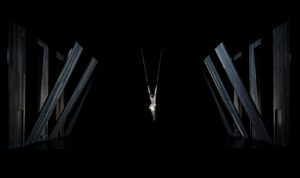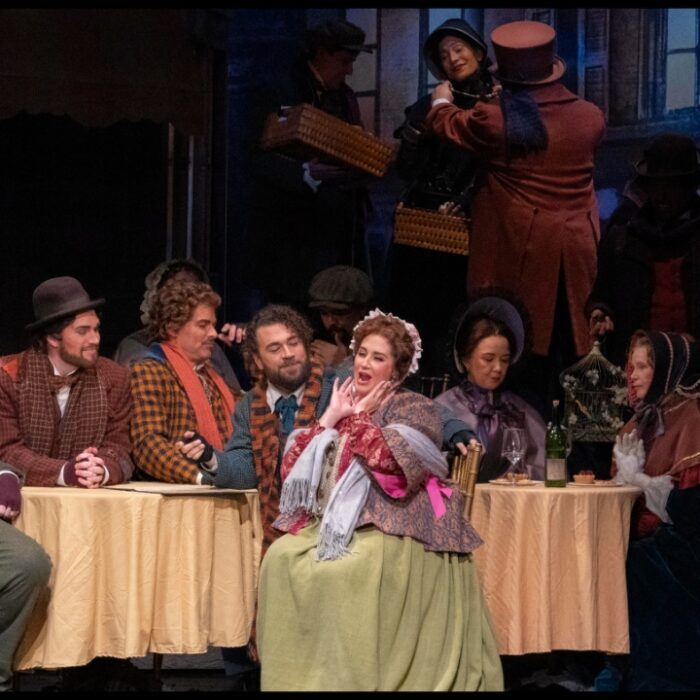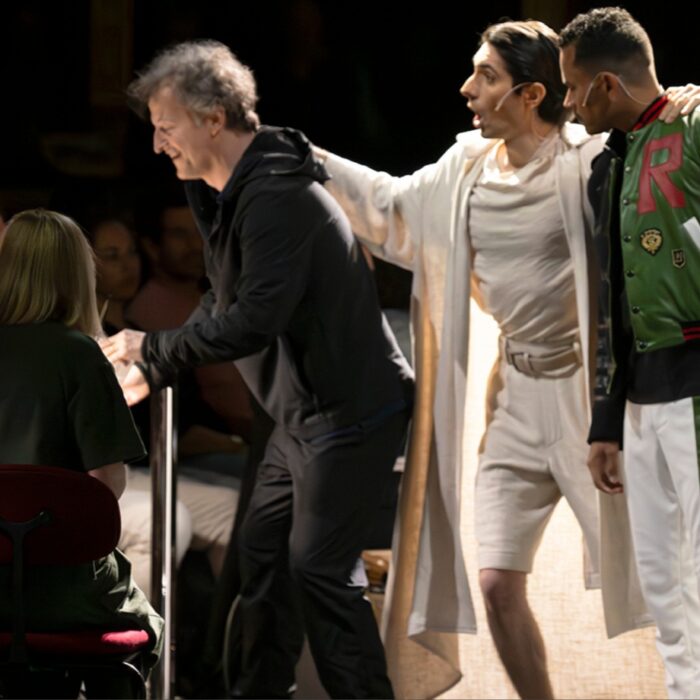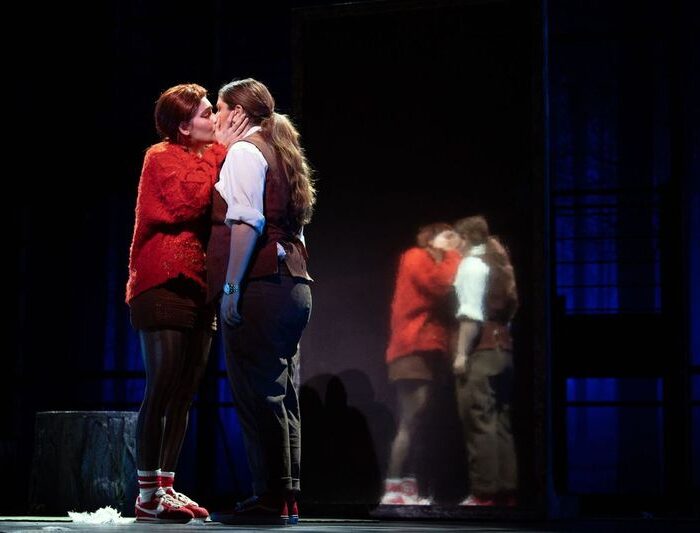
Janacek Brno Festival 2022 Review: From The House Of The Dead & The Glagolitic Mass
Herman’s Brilliantly Conceived & Staged Double Bill
By Alan Neilson(Photo: Marek Olbrzymek)
Would any opera house be bold enough to present a work about the horrors of life in a gulag in which the guilty and innocent are thrown together to be abused, debased and left to die? Undoubtedly, the answer is yes! What if it were to be presented in a Christian context, in which Christ walks among the prisoners, a witness to their suffering and misery, yet does not intervene? Again, the answer is likely to be in the affirmative. How about if, after their deaths, the prisoners are resurrected, saved by the blood of the redeemer, to take their place among the saints in Paradise?
The answer is now much less certain.
Well, that is exactly what Brno’s Janáček Festival agreed to, with a double bill of the composer’s final opera “From The House Of The Dead” and his “Glagolitic Mass.”
Not only were the works presented as companion pieces, but the director, Jiri Herman, fused the two so that the “Glagolitic Mass” emerged from “From The House Of The Dead” with only the briefest of pauses, without even time for the audience to applaud. Characters from the opera then reappeared in the Mass. The drama, therefore, continued seamlessly from one to the other, and it worked brilliantly. It could even be argued that the pairing of the two actually enhanced each of them individually.
“From The House Of The Dead” is a brutal depiction of life in one of Russia’s Siberian prison camps. There is no narrative as such. Instead, it presents a group of prisoners, some of whom become known to us, in a series of distinct events that occur over an unstated period of time during the 19th century. It begins with the arrival of a new prisoner, Gorjančikov, who is immediately abused and beaten, and ends when he is released.
A Picture Of Psychological And Physical Terror
The intervening events are a collage of violence, psychological torment, and abuse meted out by the guards to the prisoners and by the prisoners to each other. It is a horrifying picture of the atrocities that man can inflict on his fellow human beings, in which every attempt possible is made to debase and crush the human spirit and eliminate all hope. In the hands of the right director, it can be a bleak, painful experience to watch the scenes play out, and Herman certainly was up to the task.
From the outset, Tomáš Rusin, the scenographer, using videos of a barren wasteland of snow and iced-up rivers, created a world of isolation, far from civilization, cut off from the accepted attitudes and mores of normal life. In the dimly lit foreground, chained prisoners emerge from beneath the stage. And then the violence began!
Zuzana Štefunková Rusinová used clearly defined costumes to distinguish the guards from the prisoners: the former were dressed in 20th century, red uniforms while the shaven-headed prisoners were dressed in simple black clothes. The first notable action occurred when a guard started to torment a prisoner by offering him and then withholding a mug of water before giving him a good beating. And so the brutality continued.
Herman’s treatment of individual characters was well-crafted and nuanced and reflected underlying pathologies and the psychological damage caused by their experiences in the camp. Their movements, often angular and jerky, were exaggerated and extreme, and when excited, they became aggressive and violent. Even their facial expressions were manic, deranged by their demented energy. Their random explosions of anger, lust, and violence grew naturally from their characters.
An Expression Of What It Means To Be Human
However, what makes “From The House Of The Dead” such a powerful work is Janáček’s ability to infuse the work with an underlying humanity, which is found both within its characters and scenes. The ever-present atmosphere of wanton cruelty and oppression is unable to quash the desire of the prisoners to give expression to their existence and their own morality, no matter how perverse such expressions may appear to the watching audience, sitting in the warmth and comfort of the theatre. It was something Herman effectively highlighted.
Scenes, such as when Gorjančikov offers to teach the young Aljeja to read, were brought to the fore in a sensitive manner so that the background against which they take place is never ignored. As Aljeja’s face lights up at the prospect of being able to read, another prisoner arrives to disrupt the situation, mocking them both before pushing them back to work. There is nowhere totally private; nowhere where alternative values will not be mocked, derided, or worse, met with physical violence.
Herman really brought home the fundamental clash between the prisoners’ need to express themselves and their distorted and damaged psychologies in the scene in which they perform a play about Don Juan. Acting out the parts gave them the opportunity to convey a whole series of emotions which had been suppressed and to act out situations that they had been denied for so long, that is to express themselves as human beings. Herman had them act out the play with enormous energy and unbounded enthusiasm, but in an exaggerated way to reflect their uncontrolled, distorted emotions and expose their deeper aggressive and lustful tendencies. It was brilliantly managed.
The prisoners are portrayed as believers. When the priest arrives in the camp to distribute alms and say mass, Herman mocks him as he marches around in an absurd manner. Yet the prisoners fall to their knees and kiss his robe and the cross. They are not mocked, as unlike the priest, their faith is genuine.
Herman’s portrait was not, by any stretch of the imagination, an attempt to sentimentalize the prisoners. They included murderers, thieves, and rapists. Many would slit your throat for the coat on your back. They were unpleasant, even evil, people, but they were people with a humanity, no matter how deeply it had been corrupted or buried, and this was how he portrayed them.
Moreover, it was a production fully in line with Janáček’s music. The dramatic flow of the staging was always tightly allied to the musical flows and brilliantly captured the fundamental optimism that inhabits the score, as well as its darker, despairing passages, in which one can almost feel the violence and aggression. The placement of a timpanist, dressed as a guard, on either side of the stage was a master stroke, so that the beating of the drums coincided with the beatings received by the prisoners.
Overt Christian Symbolism
The introduction of Christ into his reading, however, added a note of controversy. At the beginning of the opera, Christ was hanging in chains above the stage as the prisoners emerged. When the prisoners are beaten, it is Christ who writhes in agony as the blows fall upon the victims. He was an ever present, suffering alongside the prisoners.
Such an obvious Christian interpretation of the opera may well have sat uneasily with many people, especially in this secular age, but the arguments for such a reading are strong. Janáček stated that each of the characters “has a spark of God in them.” More importantly, however, the libretto was complied by Janáček from passages taken directly from Dostoyevsky’s “The House Of The Dead,” which itself was based on his four-year period spent in a Siberian prison camp. Dostoyevsky believed completely in the resurrection and saw redemptive qualities in the prisoners, no matter how brutish and repugnant their behavior.
Singers Emerge And Disappear Into The Background
The work is essentially a work without any major roles in the traditional sense, and the chorus is almost an ever present. Characters come to prominence by emerging from the chorus and then dissolving back into it when their part is over. As a group the chorus performed exceptionally well. They sang with real passion and meaning, and their acting was first rate. There were many small roles, and a few with more substance.
Baritone Roman Hoza playing the role of Gorjančikov projected an inner dignity despite his beatings and sang with warmth and attention, successfully capturing his nuanced emotional states.
Mezzo-soprano Jarmila Balážová produced a compelling performance in the role of the teenager Aljeja, capturing his decent, open, helpful, good nature. She possesses a firm, versatile voice, which she used skillfully to develop her character.
Bass Jan Štáva produced a strong performance as the Placmajor, who terrorized the prisoners and meted out summary justice in a random and violent manner. He possesses a resonant, firm voice and sang with an air of authority, coated with a vicious veneer.
Each of the three acts contains a confessional monologue about a murder committed by one of the prisoners. They are gruesome accounts that actually make good cases for their imprisonment. Their three stories are told in very different ways.
In Act one, Luka, played by the tenor Gianluca Zampieri, recounts how he killed a guard during a previous period of imprisonment. His was a half-crazed rendition in which he used his voice with an impressive degree of flexibility to express his mental and emotional instability, in which he almost descends into shouting as he relived the incident. He painted a terrifying picture of a murderer out of control, but his underlying pain was also clearly expressed.
In Act two, the tenor Peter Berger, in the role of Skuratov, produced a lyrically pleasing account of how he murdered the fiancé of a girl he loved. The murder is just a by-product of his love for the girl, whom he remembers fondly.
In Act Three, it was the turn of Šiškov, played by baritone Pavol Kubán. He produced an emotional, animated performance, still possessed by the same emotions that drove him to murder his wife and was still raging at Filka, the man he blamed for his crime.
The musical side of the production was in the hands of the soon-to-be musical director of Covent Garden, Jakub Hruša. He elicited a compelling reading from the Orchestra of the Janacek Theatre Brno with a dramatically nuanced and intensely satisfying reading. Throughout the performance the onstage drama and the music were finely attuned, even the smallest of dramatic incidents was highlighted in the musical detail. The textures were beautifully revealed, and the contrasts between the thinner and thicker passages were wonderfully managed. However, the real glory of Hruša’s conducting was his ability to bring out and develop the beauty and optimism that thread their way through the score’s disturbing, painful and upsetting sections.
Glagolitic Mass
At the end of “From The House Of The Dead,” Christ hanging from chains above the stage, falls dead onto the floor, and the prisoners, with their backs to the audience, raise their arms in praise to the savior who has given his life for them. The performance, to the sound of bells and bird song, immediately transitions into the “Glagolitic Mass.”
Lasting approximately 40 minutes, the work recounts the resurrection of Christ. Herman presents it as a dramatic work, in which the prisoners and others watch on as Christ is reborn, wrapped in the cloth of God and the Holy Spirit. They then thank Christ for his sacrifice and celebrate his gift of eternal life.
Herman connects the two works more than just through the figure of Christ. Throughout “From The House Of The Dead,” characters appear in non-speaking roles, usually as projections of the prisoners’ memories: women they have loved or killed. They now reappear in the Mass as chorus members or in the case of Katerína Knežíková, who was the woman murdered by Šiškov, as the soprano soloist. The prostitute in “From The House Of The Dead” reappears as Mary Magdalene and washes Christ’s feet. The two works thus become inextricably intertwined.
Knežíková impressed with the beautiful quality of her singing. She possesses a secure voice with a bright, luminous tone, which she used effectively to craft detailed and emotionally strong lines. The other soloists: mezzo-sopranos Balážová and Jana Hrochová; tenors Berger and Eduard Martyniuk; basses, Štáva and Josef Škarka all performed their parts well.
It is the chorus, however, that plays the central role, and it produced a splendid performance, one that captured Janáček’s brilliance at writing choral music. It was by turn uplifting and joyful, adoring and haunting.
Hruša again created a powerful performance that was attentive to the details of the staging and successfully brought out the high emotions in play. His management of the large chorus, soloists, and full orchestra was also impressive, maintaining a near-perfect balance throughout the performance.
An Ending That Justifies Herman’s Staging
At the end of “From The House Of The Dead,” Aljeja despairs at Gorjančikov’s departure. He is alone once again, among the brutality and violence of the camp. Will he ever know freedom?
As the Mass draws to a close, Aljeja stands facing the audience. The backdrop clears to reveal a sun-kissed, green, spacious valley surrounded by hills. He turns and runs toward them: his freedom has been resurrected through Christ.
This was a brilliantly conceived production, magnificently staged and performed. Probably, if “From The House Of The Dead” had been played on its own, then the overt religious symbolism would have fallen flat. But when combined in this manner, both works were enhanced.
Dostoyevsky believed that it is only through the irrationality of faith that one can endure. Surely, given that he was the source for the opera, Herman’s interpretation is perfectly legitimate and reasonable. Moreover, by allowing the Glagolitic Mass to emerge “From The House Of The Dead,” he is highlighting the message contained within both works.



